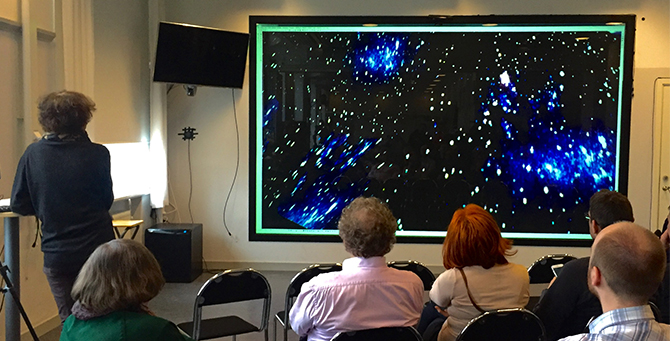VR-Cube Retrospective Seminar
Gert Svensson, PDC
The Virtual Reality Cube or VR-cube at PDC was a room to display computer generated stereoscopic 3D images. The VR-cube was a development of the original Cave design that was created in the Electronic Visualization Laboratory at the University of Illinois in Chicago by Carolina Cruz-Neira, Dan Sandin, and Tom DeFanti. The KTH VR-cube gave a realistic experience of actually being immersed in a virtual world. Our VR-cube was the first facility in the world to have a projection on all six surfaces of the cube, and the VR-cube also had a unique 3D sound capability.
The VR-cube at KTH was inaugurated in 1998 by the King of Sweden and soon became a major attraction for visitors to KTH. The cube was used both for scientific visualization and by artists and designers. For ten years until 2008 the cave was used in a number of projects: some were projects of a scientific nature and others were more artistic. The VR-cube was shut down in 2008 as the technology was becoming old and the cost of operating the gigantic installation had become too high.
Recently Gert Svensson (from PDC) and Leif Dahlberg (from KTH Media Technology and Interaction Design) arranged a retrospective seminar about the VR-cube and its use by artists. The seminar was held on the 3rd of March 2016, and aimed to summarize the ten years of experience of the scientists and engineers collaborating with artists on projects involving the VR-cube. The seminar also had a secondary purpose, which was to look forward and discuss how science and art could collaborate in the future. Leif Dahlberg is responsible for creating a Centre for Art, Technology and Design, and also a doctoral program in these areas.
During the seminar Gert Svensson and Hans Hauska from KTH talked about the technical background of the VR-cube and about the experience of working with artists. The artists Teresa Wennberg, Birgitta Nord Nylund and Tomas Colbengtson (Bino and Cool) described their experience as artists working with this technology and together with engineers. The seminar ended with an open discussion on how to promote collaboration between science and art.
